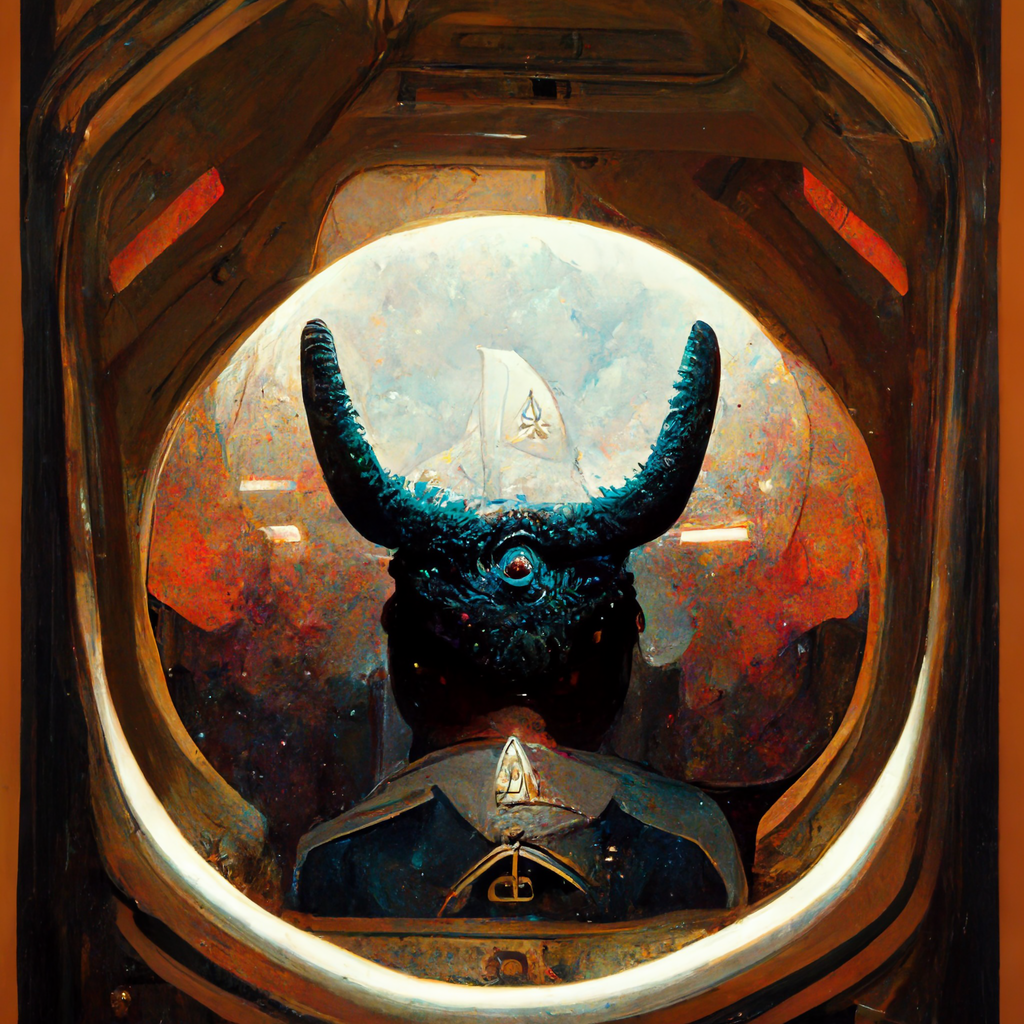BEELZEBUB’S TALES (7)
By:
March 31, 2023

Beelzebub’s Tales to His Grandson (dictated 1924–1927, and thus a work of Radium Age proto-sf, although it wouldn’t see publication until after the author’s death in 1949) is the first section of a never-completed magnum opus to be titled All and Everything. Gurdjieff would later explain that through this work he intended “to destroy, mercilessly, without any compromises whatsoever, in the mentation and feelings of the reader, the beliefs and views, by centuries rooted in him, about everything existing in the world.” HiLoBooks is pleased to serialize a selected excerpt from Beelzebub’s Tales here at HILOBROW.
ALL INSTALLMENTS: 1 | 2 | 3 | 4 | 5 | 6 | 7 | 8 | 9 | 10.
BOOK I
CHAPTER V: The system of Archangel Hariton
“Shortly afterward, again under the supervision of the Great Archangel Adossia, practical tests open to all were made with this new invention, which was later to become so famous.
“The new system was unanimously acknowledged to be the best, and soon
it was adopted for service throughout the Universe, gradually superseding all previous systems.
“At the present time this system of the Great Angel, now Archangel, Hariton is in use everywhere. The ship on which we are now flying is based on the same principles, and its construction is similar to that of all ships built according to this system. It is not very complicated.
“The whole of this great invention consists of a single ‘cylinder’ shaped like an ordinary barrel.
“The secret of this cylinder lies in the disposition of the materials of which its inner walls are composed.
“These materials are isolated from each other by means of ‘amber’ and, owing to their arrangement in a certain order, have the property of acting on any cosmic gaseous substance entering the space they enclose — whether ‘atmosphere,’ ‘air,’ ‘ether,’ or any other combination of homogeneous cosmic elements — causing it immediately to expand within the cylinder.
“The bottom of this ‘cylinder-barrel’ is hermetically sealed, but the lid, although it can also be tightly closed, is hinged in such a way that on pressure from within it opens, and then shuts again.
“So, Your Right Reverence, if this cylinder-barrel is filled with atmosphere, air, or any other such substance, the action of its walls causes these substances to expand to such an extent that the interior becomes too small to hold them.
“Striving to find an outlet from this constricted interior, they naturally press against the lid of the cylinder-barrel, which opens on its hinges and allows these expanded substances to escape, and then immediately closes again. Since in general Nature abhors a vacuum, as soon as the expanded gaseous substances are released, the cylinder-barrel is again filled up with fresh substances from outside, and they in their turn undergo the same process, and so on without end Thus the substances are always being changed, and the lid of the cylinder-barrel alternately opens and shuts.
“Fixed to this lid is a very simple ‘lever,’ operated by the movement of the lid, which sets in motion some also very simple ‘cogwheels,’ and these in turn revolve fans attached to the sides and stern of the ship itself.
“Thus, Your Right Reverence, in spaces where there is no resistance, contemporary ships like ours simply fall toward the nearest stability, but where there are any cosmic substances that offer resistance, it is these substances, no matter what their density, that are acted upon by the cylinder and enable the ship to move in any desired direction.
“It is interesting to note that the denser the substance in any given part of the Universe, the better the charging and discharging of the cylinder-barrel proceed, and in consequence, of course, the rate of movement of the levers is accelerated.
“Nevertheless, I repeat, a region without atmosphere, that is, a space containing only ‘world ethernokrilno,’ is the best for contemporary ships as it was for earlier ones, because it offers no resistance at all, and the law of falling can therefore be employed to the full with no need for the work of the cylinder.
“Furthermore, contemporary ships have the advantage that in atmosphereless spaces they can be given an impetus in any direction, and can fall wherever intended without the complicated manipulations necessary in ships of the system of Saint Venoma.
“In short, Your Right Reverence, both in convenience and simplicity, contemporary ships are beyond comparison with the earlier ones, which were often exceedingly complicated and at the same time had none of the possibilities of the ships we use now.”
RADIUM AGE PROTO-SF: “Radium Age” is Josh Glenn’s name for the nascent sf genre’s c. 1900–1935 era, a period which saw the discovery of radioactivity, i.e., the revelation that matter itself is constantly in movement — a fitting metaphor for the first decades of the 20th century, during which old scientific, religious, political, and social certainties were shattered. More info here.
SERIALIZED BY HILOBOOKS: James Parker’s Cocky the Fox | Annalee Newitz’s “The Great Oxygen Race” | Matthew Battles’s “Imago” | & many more original and reissued novels and stories.
